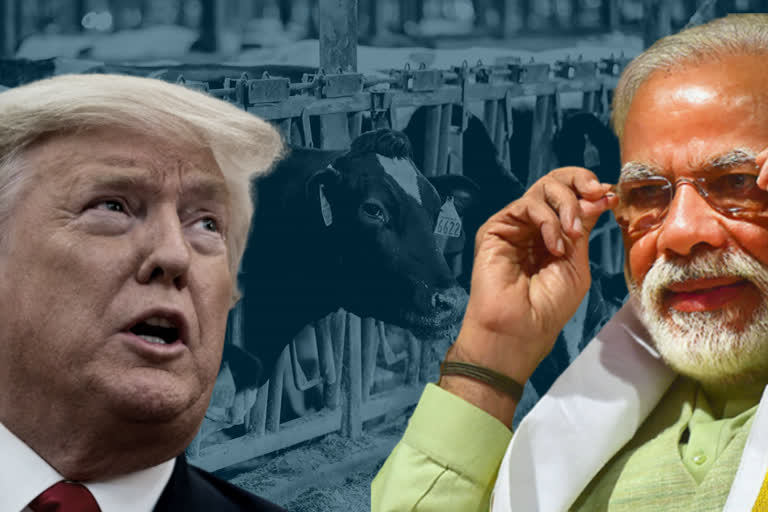New York: The visual spectacle of US President Donald Trump and Prime Minister Narendra Modi sharing the stage in India later this month is a victory in itself, with or without the underpinning of a trade deal, US-India strategy mavens in Washington previewing Trump's February 24-25 visit are saying.
"The fact that the trip is happening at all is a success for India-US relations. There was a great deal of speculation that the visit would be tied to the completion of an India-US trade deal that has been the subject of years of gruelling negotiations. I commend President Trump for deciding to make the visit with or without a trade deal," Jeff Smith, South Asia Research Fellow at Heritage Foundation in Washington told IANS.
Read also: Ahead of Trump's India visit, wall being constructed near slum in Ahmedabad
With Trump's top negotiator Robert Lighthizer avoiding a New Delhi trip, hopes for a "gold standard" trade deal have quickly gone south. Lighthizer has worked behind the scenes on Trump's most ambitious trade deals, including most recently with China, Mexico and Canada.
Read also: Ahmedabad hides slum stretch ahead of Trump's maiden visit
Experts are now focusing on how Trump and Modi are going to drive home the message that some of the recent trade irritants have been smoothened out.
"So, we know what the gold standard looks like. But for a program like this (Trump's India visit), as long as the two leaders have something to say about what that they need to do and that they've got 80 percent of the way there, that would count as a victory," Richard Rossow, Senior Adviser and Wadhwani Chair in US India Policy Studies at the Center for Strategic and International Studies told IANS.
Rossow said, "A general announcement about the main principles of the agreement seems to be enough where they can claim victory, even as a lot of businesses will be scratching their heads after the fact!".
According to Jeff Smith, "Just having President Trump present to give a speech, get some face time with Prime Minister Modi, and sign some bilateral deals, including defence sales, will mark a success for bilateral relations. Of course, if the two sides are able to finalise a trade deal at the last minute, the visit will be considered an even greater success."
Trump will be the fourth consecutive president to travel to India. At this time, sources both in Washington and New Delhi are pointing to ever closer alignment on the lion's share of bilateral trade issues but closure is proving elusive despite many months of painful negotiations. Market access for agricultural products including dairy and India's push for reinstatement of Generalised System of Preferences (GSP) status headline the gaps between the two sides.
Trump on Tuesday said that he's saving the big trade deal for later in the year, repeating his stock lines "we're not treated very well by India" and "I happen to like Prime Minister Modi a lot."
Despite a lot of attention from US lawmakers about the situation in Kashmir after the revocation of Article 370, Rossow said the US administration has largely stuck with what it considers its "broad mandate", pushing hard on commercial interests and security cooperation with India.
Trump's visit comes against the backdrop of trade hostilities between the two countries that have escalated since the Trump administration slapped tariffs on steel and aluminium from India in 2018. Plenty of baggage has been piled on since then. New Delhi held off from immediate retaliation but finally allowed retaliatory tariffs to kick in June 2019 after the Trump administration revoked India's Generalized System of Preferences (GSP) status early 2019. The GSP gives duty-free market access to exports from developing countries.
In November 2018, the US cranked up the pressure on countries importing oil from Iran, handed a six-month waiver to India and then slammed the brakes altogether in Spring 2019. In October 2018, India signed a $5.5 billion deal to buy Russian S-400 air defence systems, which will begin arriving late 2020. The Trump administration's Countering America's Adversaries Through Sanctions Act (CAATSA) strikes at the heart of this deal and there are no guarantees yet of a waiver for India.
US goods exports to India in 2018 were $33.5 billion, up 30.6 percent from 2017 and up 89.5 percent from 2008. US total exports of agricultural products to India totalled $1.5 billion in 2018. Leading export categories include tree nuts ($663 million), cotton ($333 million), fresh fruit ($163 million), dairy products ($48 million), and prepared food ($33 million).
With inputs from IANS



